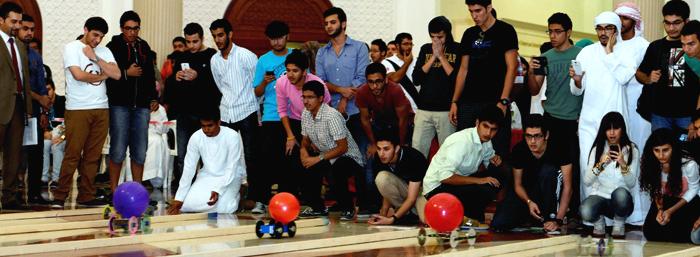- About
- Admissions
- Study at AUS
- Prospective Students
- Bachelor's Degrees
- Master's Degrees
- Doctoral Degrees
- Admission Publications
- International Students
- Contact Admissions
- Grants and Scholarships
- Sponsorship Liaison Services
- Testing Center
- New Undergraduate Student Guide
- New Graduate Student Guide
- File Completion
- New Student Orientation
- Payment Guide
- Executive Education
- Students with Disabilities
- Academics
- Life at AUS
- Research
- Contact Us
- Apply Now
- .

Engineering freshmen at AUS compete to build fastest motor-less racecar
Almost 600 engineering freshmen at American University of Sharjah (AUS) built motor-less racecars out of basic material such as paper, CDs, plastic cups, rubber bands, and balloons, at the 10th NGN 110 Introduction to Engineering and Computing Competition held on Sunday, December 15, 2013. The students were divided into 112 multidisciplinary teams and had to practice their engineering skills to design cars that could cross a 10-meter racetrack in the shortest time yet have the lightest car weight.
The competition, now in its 10th edition, is part of the first-year course Introduction to Engineering and Computing (NGN 110) taken by all AUS engineering students. AUS offers bachelor of science degrees in chemical, civil, computer, electrical, industrial and mechanical engineering, as well as computer science. The participants represented all College of Engineering majors, and the goal of the competition was to help students enhance their teamwork, engineering design, problem solving, time management and communication skills.
"All students receive the same project idea and are given six weeks to complete their project," said Dr. Fadi Aloul, Associate Professor in the Department of Computer Science and Engineering, and coordinator of the competition. "The goal of the competition is to challenge students to think out of the box, be innovative, learn how to research, work with others, seek experts, explore new ideas and convert solutions from a simple idea to a real product. The competition also encourages students to interact with each other to produce creative designs and compete with each other. Students prepared hundreds of models, many of which were impressive and showed the quality and effort put into their designs. Their hard work, dedication and excitement made the event a great success," he added.
The first place was won by Abdulla Ali AlFalasi, Hatim Abdalla Mohamed, Ahmed Mohamed Yosri Galall, Ahmed Izzedin El Sayed and Danish Raza Nanji. The team won AED 1,750 and their car weighed 52 grams and crossed the track in 4.72 seconds.
The competition judges included Dr. Ayman El-Hag, Dr. Ibrahim Deiab, Dr. Murat Gunduz, Dr. Salwa Beheiry and Naveed Nawaz from the AUS College of Engineering. The best designs were recognized at the end of the competition, and awards and cash prizes were distributed to members of the winning teams by Dr. Leland Blank, Dean of the College of Engineering.
According to Dr. Blank, "The objective of such a competition is for students to be able to work calmly under the stress that is created from a team-building environment where you have particular fixed parameters: time, weight, speed. You have to compete with other people you may know, and you learn to compete in a friendly way so that everybody wins. Whether you get the prize or not you win because you've accomplished something, you've grown and you've worked with people in a way you may have never done before. So what's the goal? The goal is the experience and to gain knowledge, and to be, in the long run, a better engineer."
The event attracted a large audience of students, faculty members and university officials, including Dr. Thomas Hochstettler, Acting Chancellor; Salem Al Qaseer, Vice Chancellor of Public Affairs; Ali Shuhaimy, Vice Chancellor of Enrollment Management; Dr. Gautam Sen, Vice Provost of Research and Graduate Studies; and Dr. Mahmoud Anabtawi, Dean of the College of Arts and Sciences.
In previous years, the competition required students to design and construct bridges, cars, helicopters, boats and paper planes, among other structures. To see past competitions, click here.

